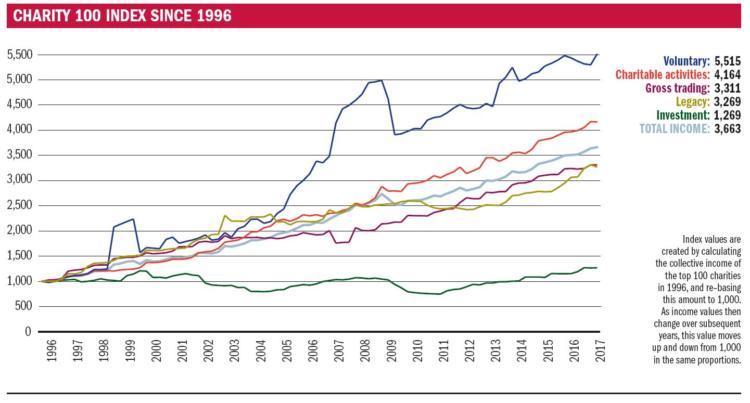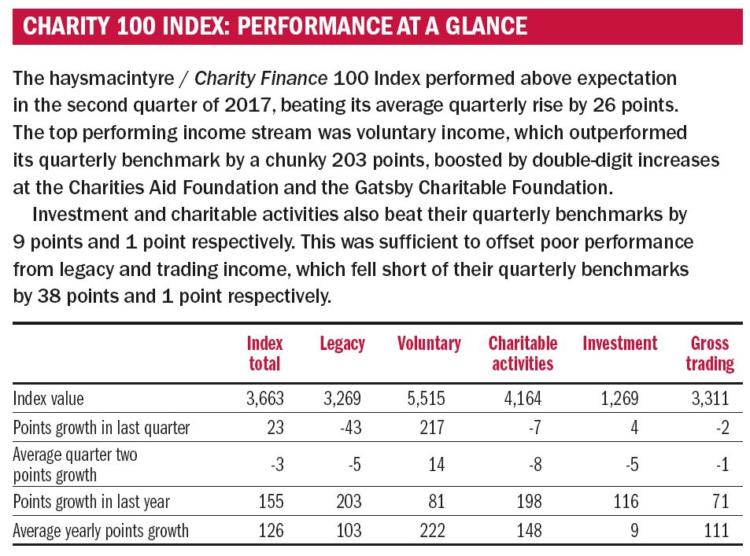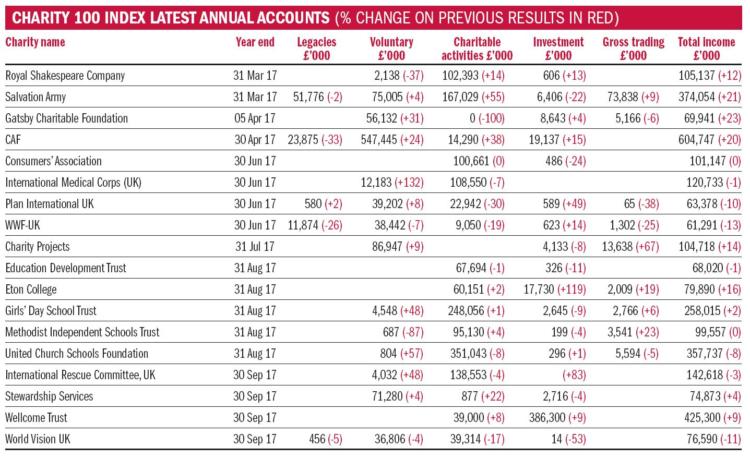Strong results from the Charities Aid Foundation (CAF) and the Gatsby Charitable Foundation have given the haysmacintyre / Charity Finance 100 Index a welcome boost, offsetting lacklustre performance among the four other charities reporting results in the second quarter of 2017.
Recent quarters have seen big falls in the voluntary income subindex. These are likely to be a result of the fundraising scandals of 2015, which prompted many large charities to pause or withdraw from some fundraising activity. However, this time round we have two charities that rely on other types of voluntary income and were therefore not affected.
For CAF, 2016/17 was a recordbreaking year. Its income topped the £600m mark for the first time, up 20 per cent on 2015/16, and donations paid out to other charities exceeded £500m. The income increase is due mainly to a 24 per cent rise in voluntary income to £547.4m, reflecting significant giving from major donors into CAF Charitable Trusts in order to build up their philanthropic funds.
Similarly, the Gatsby Charitable Foundation reported a 23 per cent increase in income to £69.9m. This was largely the result of a 31 per cent increase in voluntary income, which included gifts totalling £55.4m from the Foundation’s principal benefactor Lord Sainsbury of Turville.
In addition to these charities, the majority of those with financial year ends falling in the third quarter have also filed their results, although these will not be added to the main Index data until September. These include top ten Charity 100 member the Wellcome Trust, which reported a 9 per cent increase in income to reach £425.3m, largely as a result of a 9 per cent increase in investment income.

Medical research charities
Across the Charity 100 and Charity 250 Indexes, the Wellcome Trust is one of 20 charities that fund medical research. They range from Cancer Research UK with annual income of £647.2m to the National Centre for Young People with Epilepsy with annual income of just over £27.7m.
The income streams of Index charities engaged in medical research are fairly diverse. Investment income generates over 90 per cent of funding at the Wellcome Trust, while trading income accounts for almost 60 per cent of income at the British Heart Foundation. Legacy income accounts for 51 per cent of income at Arthritis Research UK and 39 per cent at Parkinson’s Disease Society. Charitable activities account for over 90 per cent of income at the Royal Hospital for Neuro-disability, in the form of patient services income, and at LifeArc in the form of research contracts and royalty income.

A popular cause
According to the Association of Medical Research Charities, medical research is the most popular charitable cause in the UK, supported by over 8 million people in 2017. However, haysmacintyre partner Kathryn Burton points out: “Widespread public support for medical research charities is undoubtedly a strength, but it can lead to over-reliance on fundraising and legacy income, which have their own risks.
“New fundraising regulations may restrict charities’ activities and could impact negatively on fundraising income, while legacy income is unpredictable and vulnerable to longterm demographic trends,” she adds.
Recent years have seen a tougher enforcement approach to data protection from the Information Commissioner’s Office, the advent of the Fundraising Regulator, and the introduction of the EU General Data Protection Regulation. These have prompted many charities to reassess their fundraising practices, and several medical research charities acknowledge in their annual reports that this may impact negatively on fundraising income.
One example is Cancer Research UK. Its trustees observe: “Looking forward, we face new challenges as a result of our decision to move towards only contacting donors who have opted in to receive marketing communications from us. We know this means we’ll be speaking with fewer people and this may adversely affect fundraising income, but we hope it will enable us to build stronger relationships with our supporters.”
There is also plenty of evidence of the volatility and unreliability of legacy income. At Great Ormond Street Hospital Charity, legacy income fell by 19 per cent in 2015/16 and by 21 per cent in 2016/17, reducing the contribution made by legacies to total income from 27 per cent in 2014/15 to 15 per cent in 2015/16.
As well as unpredictability, legacy income is also subject to long-term demographic trends. According to Richard Radcliffe of legacy advisory firm Radcliffe Consulting, there are an increasing number of calls made on the funds of the elderly.
“Retired prospects are in a quandary,” he says. “Care costs, university fees, children getting divorced or changing partners and helping children and/or grandchildren onto the property ladder are all circumstances that change frequently. That is why so many legators are putting conditional legacies into their wills …which means you only get the legacy if the entire family is wiped out,” he says.
Burton adds: “To mitigate the risks of fundraising and legacy income, medical research charities are looking to diversify their income streams. A relatively recent development is the establishment of blood and/or tissue banks relating to specific conditions, which can be sold to third parties such as pharmaceutical companies.”
She cites ABBUK as an example. It is a 50:50 joint venture between Alzheimer’s Society and Alzheimer’s Research UK, set up to establish, promote and maintain banks of tissue for research into the cause, prevention and cure of Alzheimer’s disease and associated diseases and disorders.
Other income-generating strategies include long-term partnerships with corporate organisations and philanthropists. At Cancer Research UK, corporate partnerships with Scottish Power, Tesco, TK Maxx, Ultra White Collar Boxing, Wilko, Warburtons and Slimming World raised £21m in 2016/17.
As well as consolidating existing relationships, the cancer charity is looking to develop new partnerships with BT and WHSmith and with philanthropists, in the UK and abroad, to fund specific areas of its activity.

Charity 100 index: Performance at a glance
The haysmacintyre / Charity Finance 100 Index performed above expectation in the second quarter of 2017, beating its average quarterly rise by 26 points. The top performing income stream was voluntary income, which outperformed its quarterly benchmark by a chunky 203 points, boosted by double-digit increases at the Charities Aid Foundation and the Gatsby Charitable Foundation.
Investment and charitable activities also beat their quarterly benchmarks by 9 points and 1 point respectively. This was sufficient to offset poor performance from legacy and trading income, which fell short of their quarterly benchmarks by 38 points and 1 point respectively.









